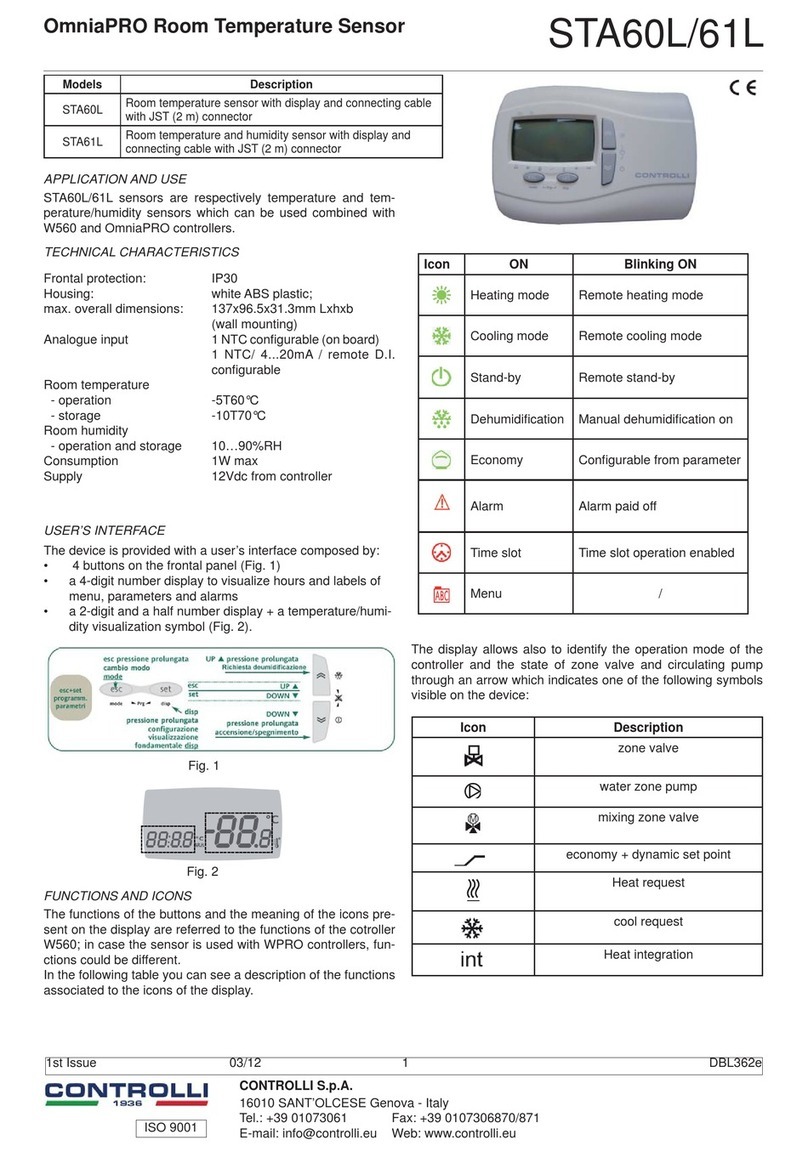Rev. d 01/1 2 DMP052E
TABLE OF CONTENTS
INTRODUCTION................................................................................................................................................3
USER INTERFACE ............................................................................................................................................4
FUNCTION DESCRIPTION ...............................................................................................................................5
GENERAL.......................................................................................................................................................5
FOR ANALOGUE OUTPUT 1 IT IS POSSIBLE TO SELECT: ...................................................................5
FOR THE 1 ON/OFF DIGITAL RELAY OUTPUT IT IS POSSIBLE TO SELECT: .....................................6
FOR ANALOGUE OUTPUT 2 IT IS POSSIBLE TO SELECT: ...................................................................6
FOR THE DIGITAL RELAY OUTPUT 2 IT IS POSSIBLE TO SELECT:....................................................8
CONTROL TYPE............................................................................................................................................9
SET-POINT COMPENSATION.................................................................................................................... 10
MIN/MAX HUMIDITY LIMITS ON A1 AND D1 LOOPS............................................................................... 11
OPERATING MODES.................................................................................................................................. 12
MANUAL OVERRIDE KEY FOR THE OPERATING MODE....................................................................... 12
CLOCK ENABLE WITH TIME SCHEDULE.................................................................................................13
OUTSIDE DIGITAL ENABLE....................................................................................................................... 13
FACTORY DATA LOAD .............................................................................................................................. 13
STORING DATA IN PERMANENT MEMORY ............................................................................................ 14
LOADING DATA FROM PERMANENT MEMORY...................................................................................... 14
REMOTE SET.............................................................................................................................................. 14
LINKBUS COMMUNICATION ..................................................................................................................... 14
ENTHALPY COMPARISON WITH OUTDOOR HUMIDITY SENSOR FROM ANOTHER W500H ............ 15
MODBUS COMMUNICATION..................................................................................................................... 16
USE OF SUPERVISION OUTSIDE SENSOR FOR COMPENSATION...................................................... 16
ERROR SIGNALLING.................................................................................................................................. 16
FRONT PANEL AND DATA ACCESS MENU................................................................................................. 17
PARAMETER CONFIGURATION MENU....................................................................................................18
Parameters Loop PA1 - Mode A1............................................................................................................. 18
Parameters Loop PA1 - Mode A2............................................................................................................. 19
Parameters Loop PA1 - Mode A3 / Mode A4........................................................................................... 19
Parameters Loop Pd1 - Mode D1............................................................................................................. 20
Parameters loop Pd1- Mode D2............................................................................................................ 20
Parameters Loop Pd1- Mode D3 .......................................................................................................... 21
Sequence Parameters Pd1and Pd2- Mode D4................................................................................. 21
Parameters Loop PA2- Mode A1 .......................................................................................................... 21
Parameters Loop PA2- Mode A2 .......................................................................................................... 22
Parameter Loop PA2- Mode A4............................................................................................................ 22
Parameter Loop PA2- Mode A3............................................................................................................ 23
Parameter Loop Pd2 - Mode A1........................................................................................................... 23
Parameter Loop Pd2 - Mode A2........................................................................................................... 24
Parameter Loop Pd2 - Mode A3........................................................................................................... 24
PROGRAMME MENU FOR OPERATING MODES AND TIME SCHEDULES........................................... 25
Setting - Analogue output 1 / 0-10Volt PA1 Loop............................................................................ 26
Setting - Analogue output 2 / 0-10Volt PA2L o o p .............................................................................. 27
Setting - Relay Digital output 1 Loop Pd1 ............................................................................................. 27
Setting - Relay Digital output 1 Loop Pd1 ............................................................................................. 28
Setting - Relay digital output 2 Pd2 – 1, 2 and 3 operating mode ........................................................ 28
Setting - Relay digital output Pd1and Pd2 – 4 operating mode......................................................... 29
MENU DIAGRAM......................................................................................................................................... 30
TEMPERATURE CONTROL PARAMETER TABLES (LEVEL 1)................................................................... 31
HUMIDITY CONTROL PARAMETER TABLES (LEVEL 1)............................................................................. 32
TABLES OF OPERATING MODES AND TIME SCHEDULES (LEVEL 2).................................................. 33
SYSTEM APPLICATIONS............................................................................................................................... 35




























